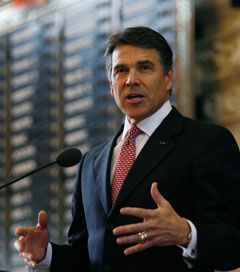Texas has been adding jobs faster than the rest of the nation, a fact that has become especially notable in the past couple of years — I recently saw it referred to as the Texas “jobs juggernaut” — as overall job growth has been so poor.
But what’s the story here? Oddly, it’s rare to see anyone in this debate talking in terms of models — that is, the kind of stylized, simplified, but internally consistent stories (not necessarily mathematical) that are what economic analysis is all about. So let me try to fill that gap by offering three informal models of what might be going on in Texas.
In each of these stories, I imagine, to clarify things, an initial state in which America is divided into two identical regions; call them Texas and New York. Each of these regions has a labor force that lives in houses; I ignore other factors of production, except that I assume that building houses requires land, which is in limited supply. And we assume that initially everything is in equilibrium: wages and the cost of housing are the same in both regions.
Then something changes in Texas, which causes Texas to gain jobs faster than New York. The question is: what is the change? As you’ll see, each story has some implications about what else we should be seeing besides differential job creation. So here goes.
Model I: Demography
Assume that for some reason the population of Texas, and hence its work force, rises — say, because of immigration from Mexico, or because of high birth rates among past immigrants.
What this will do is push wages down — and the reduction in wages will lead to faster job growth. So you’ll see employment growing, but the driving force will be supply — more people looking for jobs — rather than demand.
Model II: Zoning
Suppose that Texas loosens up land-use regulations, so that housing becomes cheaper relative to New York. In that case workers will move to Texas, even if they receive somewhat lower wages than they would in New York, because of the lower cost of living. What happens next?
Well, the increased supply of labor pushes wages down, which leads to job growth — just as in the demographically driven case. In this case, however, it’s a benign thing. But it’s about housing policy, not a pro-business environment in the general sense.
Model III: Supply-Side Marvels
Finally, suppose that Texas Governor Rick Perry’s wonderful policies actually have led to a surge in business productivity. Then we’d expect to see the demand for labor rise; this will pull up wages, and draw workers into Texas, leading to high job growth.
So what do we actually see? I won’t do a lot of data-crunching right now, but surely everything we know about Texas points to some combination of models I and II.
Wages in Texas are low, and have probably fallen relative to those in slower-growth states. On the other hand, the cost of living is low, largely thanks to cheap housing. What we don’t see is either the productivity surge or the wage surge we would have expected if model III was at all right.
As Ryan Avent pointed out late last year in commentary on The Economist’s Web site, Texas’ real gross domestic product per capita has actually grown very slowly.
One more thing: how should we think about Texan performance in the recession and weak recovery? Well, I’d say that we should measure that performance around the trend — a trend that reflects the forces described by models I and II.
Of course, Texas has faster job growth than the rest of the country; it always does. The question is whether relative to that trend the state has done remarkably well. And it hasn’t: the unemployment rate in Texas is slightly higher than the rate in New York.
Truthout has licensed this content. It may not be reproduced by any other source and is not covered by our Creative Commons license.
Paul Krugman joined The New York Times in 1999 as a columnist on the Op-Ed page and continues as a professor of economics and international affairs at Princeton University. He was awarded the Nobel in economic science in 2008.
Mr Krugman is the author or editor of 20 books and more than 200 papers in professional journals and edited volumes, including “The Return of Depression Economics” (2008) and “The Conscience of a Liberal” (2007). Copyright 2011 The New York Times.
Join us in defending the truth before it’s too late
The future of independent journalism is uncertain, and the consequences of losing it are too grave to ignore. To ensure Truthout remains safe, strong, and free, we need to raise $43,000 in the next 6 days. Every dollar raised goes directly toward the costs of producing news you can trust.
Please give what you can — because by supporting us with a tax-deductible donation, you’re not just preserving a source of news, you’re helping to safeguard what’s left of our democracy.
